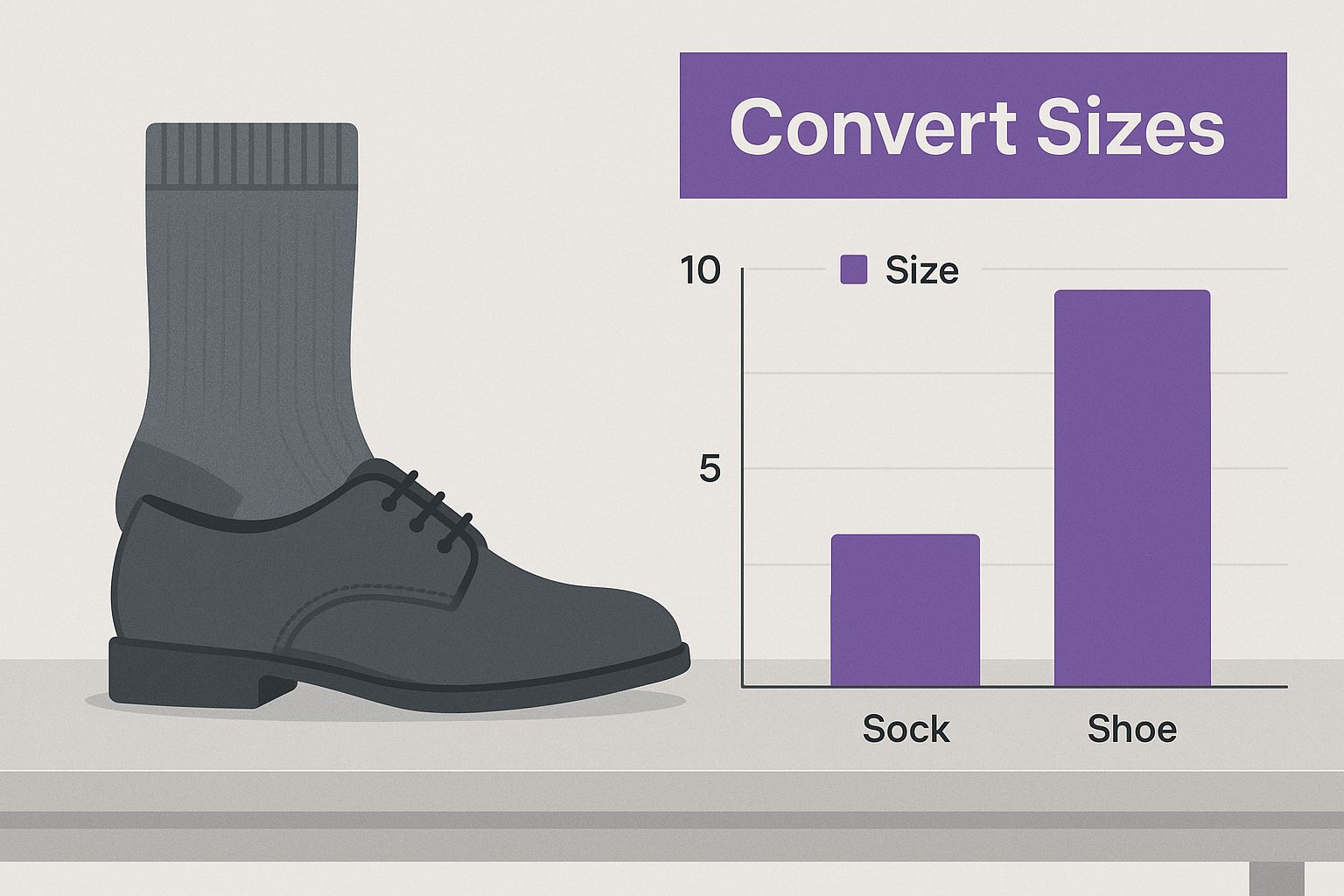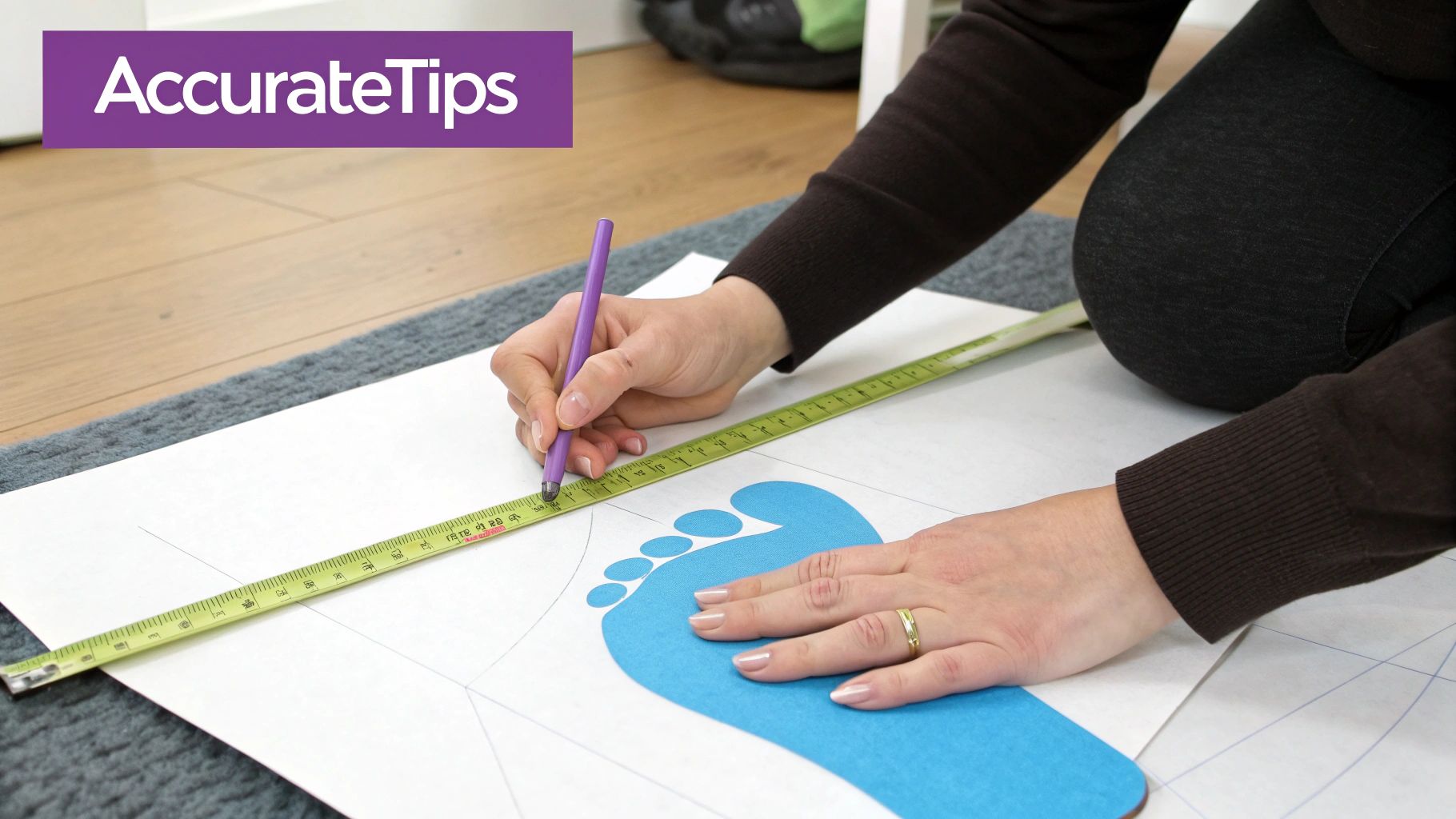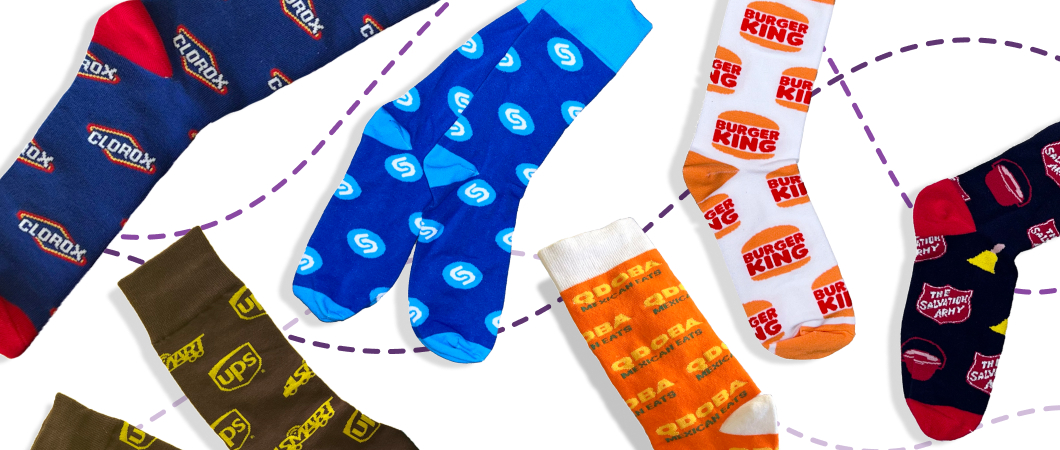You’ve probably noticed that shoes come in specific numbers like 8, 9, or 10, but socks are usually sold in vague sizes like Small, Medium, and Large. It’s not a mistake—it’s by design.
The biggest difference is this: your shoe size is a fixed length, but your sock size is a flexible range.
Think of it this way: a single sock size, let’s say a Medium, is engineered with stretchy materials like spandex. This allows it to comfortably wrap around several different shoe sizes, all without bunching up at your toes or slipping down your heel. It’s the secret weapon against blisters and general foot misery.
Why This Sizing Difference Matters
Getting the right fit is everything. It’s the line between a great day on your feet and a day filled with nagging discomfort. One sock size is designed to cover a spectrum of feet; for example, a Medium sock often fits men’s US shoe sizes 6 to 8.5 and women’s 7 to 9.5.
This chart breaks down the core philosophy behind each sizing system:
| Key Factor |
Sock Sizing |
Shoe Sizing |
| Measurement Type |
Range-based (e.g., S, M, L) |
Fixed length (e.g., 8, 9, 10) |
| Material Impact |
High stretch (spandex, nylon) |
Rigid structure (leather, rubber) |
| Fit Philosophy |
Accommodates multiple foot sizes |
Precise fit to one foot size |
| Primary Goal |
Comfort, flexibility, moisture-wicking |
Support, protection, stability |
Understanding this simple distinction is the first step to picking the perfect pair every single time. It’s a key factor for both shoppers and manufacturers, influencing everything from product design to global fit standards. For a deeper dive into market trends, check out this detailed report.
Once you get this down, you’ll never guess at your sock size again. For more tips on achieving the perfect fit, you might want to explore our other sock-related articles.
Why Sock and Shoe Sizes Are Different
You’d think your sock size would be a simple copy-paste of your shoe size, but the two sizing systems are from completely different worlds. It all boils down to their core purpose: shoes provide a rigid, protective structure, while socks are all about flexible, conforming comfort.
Shoes are built to a fixed length, but socks are engineered to stretch and adapt. It’s the magic of modern textiles. Materials like cotton, merino wool, and spandex are blended together to create a fabric that can comfortably fit a whole range of foot sizes. This is exactly why a single “Medium” sock can feel just right for someone who wears a size 7 shoe and someone else who wears a size 10.
The Role of Materials and Construction
The real secret is in the blend. While a shoe’s leather or synthetic upper is static and supportive, a sock’s construction is all about dynamic, comfortable movement. Different materials play very specific roles:
- Cotton or Merino Wool: These natural fibers form the soft, breathable base of the sock.
- Nylon: Woven in for durability, nylon helps your socks withstand all the friction and countless wash cycles.
- Spandex (or Lycra): This is the game-changer. It provides the essential stretch and recovery, letting the sock hug your foot snugly without ever feeling tight.
This thoughtful combination of materials lets sock makers use a much simpler sizing system—Small, Medium, Large—that works for a huge number of people. It’s an incredibly efficient way to do things, especially when you consider that over 15 billion pairs of socks are made worldwide every year.
Think of it this way: a shoe size is a destination—a fixed point on a ruler. A sock size is a journey—a flexible range designed to adapt to the unique terrain of your foot.
From Vague Letters to a Perfect Fit
Once you get this principle, you’re on your way to ending the struggle with poorly fitting socks for good. A sock that’s too tight can mess with your circulation, but one that’s too loose will just bunch up and cause blisters.
For certain activities, the right fit is even more crucial. Athletes need their gear to perform, which is why custom soccer socks are designed to stay put during a match without slipping or bunching. By using a sock size vs. shoe size chart, you can easily translate your shoe’s rigid number into the sock’s flexible letter, guaranteeing you get that perfect, made-for-you fit every single time.
Finding Your Perfect Fit: Adult Sock Size Chart
Figuring out sock sizes shouldn’t be a guessing game. It’s actually pretty straightforward once you know the secret: it all starts with your shoe size. Forget trying to measure your foot with a tape measure; your shoe size is the most reliable guide to finding socks that won’t bunch up at the heel or squeeze your toes.
Let’s break down how to use a standard sock size chart to get it right every time. The idea is to find your shoe size, then match it to the corresponding sock size. It’s a simple conversion that takes all the guesswork out of the equation.
This visual shows you just how directly your shoe size points to the right sock size.

Think of it this way: your shoe size is a fixed number, while sock sizes cover a flexible range of those numbers.
Adult Sock to Shoe Size Conversion Chart
To make things even easier, we’ve combined men’s and women’s sizing into one comprehensive chart. Just find your US, UK, or EU shoe size in the appropriate column to pinpoint the sock size you need.
| Sock Size |
Men’s Shoe Size (US) |
Women’s Shoe Size (US) |
UK Shoe Size |
EU Shoe Size |
| Small (S) |
|
4 – 6.5 |
2 – 4.5 |
35 – 37 |
| Medium (M) |
5 – 8.5 |
7 – 9.5 |
5 – 7.5 |
38 – 42 |
| Large (L) |
9 – 12.5 |
10 – 13 |
8 – 11.5 |
43 – 46 |
| Extra Large (XL) |
13 – 16 |
|
12 – 15 |
47 – 50 |
So, if you wear a women’s size 8 shoe, you’re a Medium sock. If you’re a man who wears a size 11, you’ll want to grab a Large. When you’re looking at unisex socks, they almost always follow the men’s sizing scale, so it’s a good idea to use that column as your guide.
For a deeper dive into getting a super-precise fit, especially for specialty or compression socks, our complete guide to sock sizing has even more detailed tips.
Key Takeaway: Your shoe size is your North Star. It’s the single best piece of information you have for finding the right sock. Trusting the chart means you’ll avoid the classic pitfalls of socks that slip down or feel way too tight.
Finding the Right Sock Size for Kids
Let’s be honest, shopping for kids’ socks can feel like you’re trying to hit a moving target. Their feet seem to sprout overnight, making what fit last week suddenly too snug.
Unlike adult sizing, which is pretty straightforward, kids’ socks are often grouped by developmental stages: toddler, little kid, and big kid (or youth). It’s tempting to buy socks a size up, hoping they’ll grow into them, but that’s a common mistake. Baggy socks bunch up inside their shoes, leading to blisters, discomfort, and even wobbly steps for little ones still mastering their balance.
Kids and Youth Sock Size Conversion Chart
To help take the guesswork out of it, we’ve put together a simple chart that connects your child’s shoe size with the right sock size. Just remember to measure their feet every so often—you’d be surprised how quickly a growth spurt can sneak up on you.
This chart helps parents find the correct sock size for their children based on shoe size and approximate age.
| Sock Size |
Kids’ Shoe Size (US) |
Approximate Age |
EU Shoe Size |
| XS (X-Small) |
Toddler 4 – 7 |
1 – 2 years |
19 – 23 |
| S (Small) |
Toddler 7.5 – 11 |
3 – 4 years |
24 – 28 |
| M (Medium) |
Little Kid 11.5 – Youth 1 |
5 – 7 years |
29 – 33 |
| L (Large) |
Youth 2 – 5.5 |
8 – 10 years |
34 – 38 |
As you pick out socks, think about the shoes they’ll be wearing. A good kids’ shoe has a roomy toe box that lets their toes spread out naturally—something that’s super important for healthy foot development. The right sock supports this by fitting snugly without squeezing their toes.
Parenting Pro-Tip: If you’re stuck between sizes, it’s usually better to go with the slightly snugger option. A little stretch is fine, but a sock that’s too loose is a guaranteed recipe for slipping, bunching, and complaints.
Navigating International Sizing

Shopping from international brands can feel like you need a secret decoder ring. Sizing systems in the US, Europe (EU), and the United Kingdom (UK) all speak slightly different languages, which makes a simple one-to-one conversion almost impossible.
It’s not just that the numbers are different; the entire methodology behind them is. For instance, a European size 42 shoe might be a US men’s 9, but it’s a US women’s 11. This kind of mismatch can easily turn a simple sock purchase into a frustrating puzzle.
Decoding Global Sizing Nuances
Getting a handle on these regional quirks is the key to avoiding a drawer full of socks you can’t wear. These differences aren’t random—they’re often rooted in distinct market factors and historical manufacturing standards, which is why a universal system for shoes or socks has never really caught on.
In Europe, for example, it’s common for sock sizes to directly reference EU shoe sizes (like a Medium sock fitting sizes 38 ⅔ to 42). Head over to the US, and you’ll find charts that separate men’s and women’s shoe sizes completely. Without a global standard, brands are left to create their own multi-region charts to sell worldwide. You can see how top brands navigate this by checking out their international sizing approach.
This is exactly why a good sock size vs shoe size chart that includes international conversions is an absolute must-have.
A US size 10 is not the same as a UK size 10. For men, a US 10 is typically a UK 9.5, while for women, a US 10 is a UK 8. This shift is crucial when matching your footwear to the correct sock.
The takeaway? To shop globally with confidence, always start with what you know: your local shoe size. From there, use a reliable conversion chart to find its international twin before you even think about picking a sock size.
Common Sock Sizing Questions
Even with a perfect sock-to-shoe size chart in hand, you might still have a few questions. I get it. Sizing can be tricky, so let’s clear up some of the most common issues people run into.
What Happens If I Wear the Wrong Sock Size?
Wearing socks that are too small is a recipe for disaster. They’ll constrict your feet, which is not only uncomfortable but can mess with your circulation. Even worse, they cram your toes together, creating friction that leads straight to blisters.
On the flip side, socks that are too big will inevitably bunch up and slide down inside your shoe. This creates awkward lumps and new friction points that cause painful chafing. If you’re an athlete, that sloppy fit can seriously impact your stability and performance.
The Bottom Line: A proper sock fit isn’t just about comfort—it’s crucial for your foot health. Whether they’re too big or too small, the wrong size creates friction and pressure that always end in blisters and discomfort.
Should I Size Up or Down If I Am Between Sizes?
If your shoe size puts you right on the cusp between two sock sizes, the golden rule is to size down. Modern socks are almost always made with materials like spandex that give them plenty of stretch.
A slightly snugger fit is way better than a loose one that’s guaranteed to slip and bunch. The one exception? If you have particularly wide feet, you might feel more comfortable sizing up just to make sure the sock isn’t uncomfortably tight across the top of your foot.
Does Sock Material Affect the Size I Should Buy?
Absolutely. The material and type of sock can definitely change the size you need. A pair of thick, cushioned wool hiking socks is going to fit completely differently than some thin nylon dress socks. It’s not just about foot length; it’s about the total volume the sock occupies in your shoe.
Keep these points in mind:
- Athletic Socks: Performance socks often feature compression zones and extra padding, which can make the fit feel a bit tighter.
- Compression Socks: These are a different beast altogether. They require precise measurements, often including your calf circumference, to do their job right.
- Novelty or Dress Socks: With these thinner materials, you can usually stick to the standard size chart without any trouble.
Whenever you’re buying a specialty sock, always double-check the brand’s specific size guide. Their recommendations might be a little different from the general charts. To dig deeper into common sizing quirks, feel free to explore our detailed sock sizing FAQ page.
Ready to create socks that fit perfectly and look even better? At Custom Sock Shop, we design and manufacture high-quality, American-made socks for any occasion. Get started on your custom design today at https://customsockshop.com.


